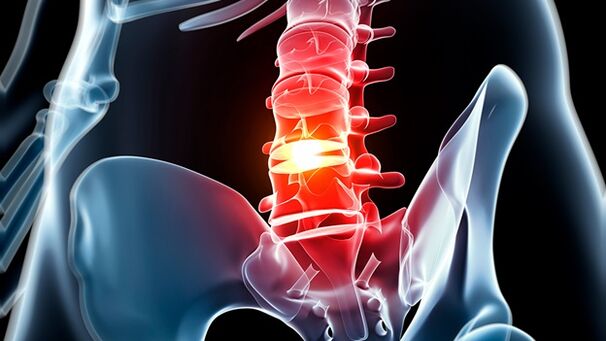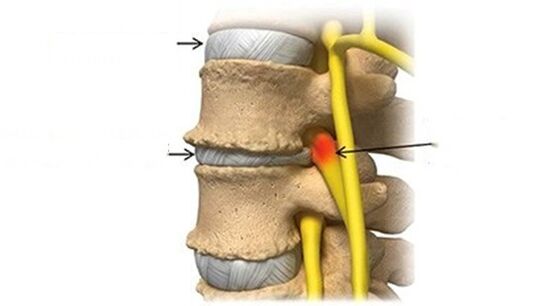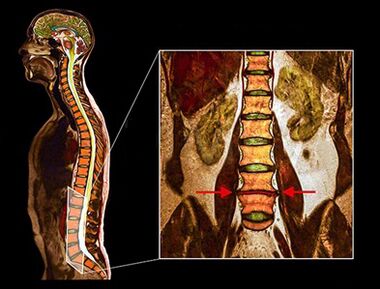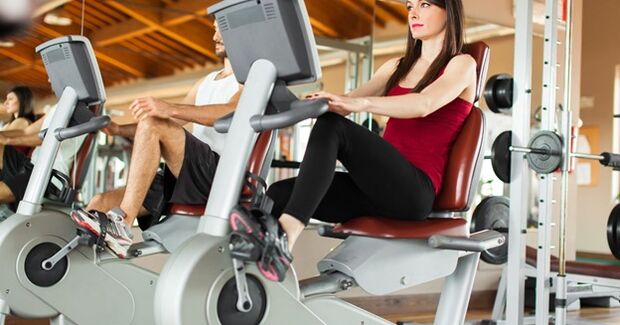Osteochondrosis (degenerative disease of the discs) in the lumbar column or in the lower back of the back is due to involutionment changes in the discs, which leads to back pain.
The intervertebral discs are hard and fibrous structures that act as ligaments between the vertebrae, absorb the blows and provide absorption of shock absorbers of the spine.The discs are elastic, but strong enough to facilitate movements, such as the inclination of the body, forward, in the back or sides.
Despite the name, osteochondosis is not considered a real disease and symptoms over time, as a rule, it does not worsen.The discs, as well as all the structures of the body, degrade and degeneration of the disc develop in all people, as part of the involutional process.
A characteristic characteristic of osteocondrosis is a gradual reduction of symptoms while the spine begins to stabilize.The treatment of the osteocondrosis of the lumbar column is focused on the minimization of pain, the stabilization of the spine and the improvement or maintenance of mobility.
Symptoms

Most cases of manifestation of osteochondosis of the lumbar column must have a slight and constant back pain, which from time to time intensifies for several days or more.
Symptoms may vary, but the most characteristic include:
- Moderate lumbar pains, constant.Pain in the damaged disc is the most common symptom of disc degeneration.Pain can spread to buttocks, groin and upper part of the thigh.This pain is generally felt as stupid and the intensity can vary from grave light.
- Acute episodes periodic pain.Back pain can be intensified for several days or weeks and therefore return to a more moderate level.The outbreaks of pain occur as degeneration and appease as the spine is gradually stabilizing.Focolars of pain can occur suddenly and the manifestations of pain often lead to a decrease in mobility.
- Local pain.The lower part of the rear part that surrounds the degenerated disc can be sensitive to the touch.Local pain is caused by inflammation and muscle tension in the area of the disc damaged by degeneration.
- Leg pain.Neurological symptoms, including numbness, weakness or acute and excruciating pain in the buttocks, thighs and/or the back of the leg, can be warned if the height of the disc is significantly reduced and the conditions for compression of the nerve roots occur.The pain in the legs with osteochondrosis of the lumbar column usually does not fall under the knee.
- A feeling of weakness or sudden instability can occur when the disc is considerably weakened and the patient has the feeling that the lower back does not work correctly.
In addition, pain can increase or decrease with certain movements or certain postures, such as:
- Pain when sitting.Sitting for long periods often causes a worsening of lumbar pain and rigidity and is relieved by standing up or changing position.
- Increase in pain during flexion or rotation.Try the spine and bend forward, back or sideways can cause intense pain in the area of the damaged disc.
- Reduced pain when walking or changing position.When the spine changes position, the pressure on the discs is reduced or redistributed by the discs to the muscles and joints.Frequently changing position, alternating erect and sitting position and short walks can help relieve stiffness and maintain pain to a minimum.
The disc degeneration should not cause symptoms of intestinal/bladder dysfunction, fever with back pain, rapid weight loss and inexplicable or intense abdominal pain.These symptoms indicate more serious conditions and often require surgical treatment.
Associated symptoms
With the osteochondrosis of the lumbar column, in addition to low back pain, other symptoms associated with disc degeneration can occur.For example:
- The proteins contained inside the disc can cause significant inflammation if they come into contact with the surrounding spinal structures and this inflammation can lead to spasms of the back muscles, as well as radial pain, with radiation in the hips and on the rear surface of the lower ends (also calls ISHIAS).
- The degeneration of the lumbar disc can contribute to the development of lumbar stenosis and / or lumbar osteoarthritis, as well as other conditions in the lower back.
- A degenerated disc can also lead to the appearance of an hernia of the lumbar intervertebral disc.Neurological symptoms with a disc hernia can be acute and intense.
- Symptoms caused by disc degeneration in the lumbar spine can vary widely depending on how quickly the disc has deteriorated and how it affects the surrounding spinal structures.
- The pain for osteochondrosis is generally caused by the deformation of the muscles that support the spine and the inflammation around the structures close to the disc.
The causes of osteochondosis of the lumbar column
Osteocondrosis occurs due to the wear and tear of the age and disorders of the disk and the degeneration process can accelerate due to injuries, general conditions, health and lifestyle and, possibly, a genetic predisposition to the development of pathological processes in the musculoskeletal system.

Osteochondrosis rarely begins with a serious injury, such as a car accident.The onset of degenerative processes is more likely to be associated with a low-energy lesion.
The legal pain associated with lumbar osteochondosis is generally generated by one or more pathological processes:
- Inflammation, the proteins of the disc are irritated by the surrounding nerves: both small nerves on the disc and potentially large nerves that go to the feet (sciatic nerve).
- The abnormal instability of the micro, when the external rings of the disc, called the fibrous ring, use and cannot effectively absorb the power carriers on the spine, which leads to movements along the vertebral segment.
- Over a long period of time, pain in the osteochondosis of the lumbar spine ultimately decreases and does not worsen.This pain relief occurs because the disc completely damaged by degeneration no longer has inflammatory proteins (which can cause pain) and the sleeping disc transitions into a stable position, eliminating the micro-movements that cause pain.
Risk factors
The factors of the lifestyle of life that influence the general state of health can influence intervertebral records.The risk factors of a degenerative disc disease (osteochondrosis) include:
- Family history of back pain or skeletal and muscle disorders
- Excessive load on the bottom of the rear, due to sport or nature of the work
- Long static loads on the discs due to prolonged seats and / or poor posture
- Lack of records support the weak back muscles
- Obesity
- Smoking or any form of nicotine consumption
The disc degeneration is part of body aging, but not all people develop pain or special symptoms.Symptoms tend to occur in case of instability, muscle tension and, possibly, irritation of the nervous root.
Diagnostics
- The history of the disease includes a detailed study of symptoms in the patient, their intensity and the relationship of pain with loads or the position of the body.Information on regular physical activity, sleep habits and past lesions are also needed.
- A physical examination is needed to study the range of movements and the status of the muscle corset.The presence of painful areas on palpation or physical anomalies is also determined.In addition, neurological tests are carried out to determine a neurological deficit.
- The above diagnostic methods are generally sufficient for the diagnosis of osteochondrosis, but an accurate diagnosis requires the use of display methods.
- Ct
- Radiography
- MSCT
- Pat
- MRI - This diagnostic method allows you to clarify the degree of degeneration, the presence of fractures, stenosis herniated discs.An MRI study is often necessary in preparation for surgical treatment in order to accurately determine the location of the degenerated disc and plan the operation.

Studies have shown that the results of magnetic resonance imaging with moderate or significant discs are found during patient scan, both with severe pain and minimum or lack of pain.In addition, many painful conditions may not appear on a magnetic resonance imaging.For this reason, the diagnosis cannot be carried out exclusively on the basis of the results of the display and the verification of the diagnosis is possible only on the basis of the totality of all the clinical and instrumental examination methods.
Treatment
The initial methods for the treatment of osteochondosis of the lumbar column and the manifestations of pain usually include the following combinations:
- Excessive painkillers They can reduce inflammation, which contributes to the discomfort, rigidity and irritation of the nerve roots.
- Prescription painkillers.With severe pain, muscle relaxing or narcotic pain relievers can be prescribed.These drugs are generally used to treat intensive and acute pain, which should last more than a few days or week.These drugs can cause addiction and cause serious side effects, so they should be used with caution.
- Heat and ice.The use of heat in the lower part of the back improves blood circulation, which reduces muscle cramps and tension and improves mobility.Ice packages can reduce inflammation and relieve moderate pain.It is useful to use heat before physical exercises to relax the muscles and use ice after physical activity in order to minimize inflammation.
- Manual therapy. Whose manipulation is carried out by a specialist is a popular pain control method in back pain.Practicing doctors, manual therapists, use hands to influence the various areas of the body in order to reduce tension in the muscles and joints.It has been discovered that manipulations are an effective measure for the reduction of temporary pain and in some cases it is as effective as drug therapy.
- Massage.Exposure with massage methods can reduce tension and cramps in the muscles of the lower back, reduce the pressure on the spine and relieve pain.In addition, therapeutic massage can improve blood circulation, guaranteeing the delivery of nutrients and oxygen to the tense muscles.
- Epidural steroid injections.The introduction of steroids in the space surrounding the spine can reduce pain impulses and inflammation.Steroid injection can be used in combination with the physical therapy program to relieve pain during physical exercises and rehabilitation.As a rule, the epidural injection of steroids allows to reduce the pain of a period from several weeks to one year.
In many cases, for effective anesthesia, a combination of treatment methods is required.The trial and error process, as a rule, is necessary to choose a treatment that is the most effective.
Long bed rest is not recommended and, normally, immobilization is possible with severe pain for a short period of time, since the lack of physical activity can lead to the weakening of the muscles and the normal support of the spine.
Exercise therapy and modification of the activity

To maintain the healthy mobility of the spine, physical exercises are needed.An effective exercise program for the lumbar column should include:
- Exercises to lengthen the muscles of the lower back, hips and pelvis, as well as the muscles of the articCIO.The seal of these muscles increases the pressure on the lumbar column and contributes to the development of back pain.
- The power exercises on the muscles of the lower back and abdomen allow you to maintain a good posture and it is better to keep the spine.The program of exercises to strengthen the muscles can include an individual exercise therapy program, the dynamic stabilization of the lumbar column, the Tai-Chi, the Pilates or others.
- Aerobic exercises with a low level of load, which increase the frequency of cardiac contractions, improve blood circulation and provide nutrients and oxygen, which is necessary to restore body tissues.For example, it can be walking, swimming and water for aerobics.
The physical exercises programs are generally adapted in each case, depending on the general state of health, the severity of pain and personal preferences.
In addition, small adjustments to daily activity (modification of lifestyle) can effectively soften pain.For example, dressing a corset when lifting weights or avoids twist when lifting weights can prevent an increase in pain due to excessive loads on the discs.The use of an ergonomic chair and an orthopedic mattress can also improve posture and reduce the load on the discs.
Surgical treatment
The surgical treatment of osteochondosis of the lumbar column is necessary in cases where the conservative treatment for 6 months was inefficient.The surgical treatment for osteochondosis is always selective, which means that the patient himself decides whether the operation should be subjected or not.
It is recommended to take into account all the factors before deciding an operation for osteochondrosis, including the duration of the recovery period, the treatment of pain during the recovery and rehabilitation of the spine.
The mergers of the vertebrae
The standard surgical treatment of osteochondosis of the lumbar column is a merger surgery in which two vertebrae passed together.The purpose of the mergers (Spondilodeza) is to reduce pain and eliminate instability in the motor segment of the spine.
All spinal merger operations are as follows:
- The damaged disc is completely removed from the intervertebral space (discontomy).
- The stabilization is performed using a bone transplant and / or tools (plants, plates, rods and / or screws).
- Then the vertebrae merge, forming a solid and immobile structure.The fight takes place within several months of the procedure and not during the operation itself.
After the operation, wearing a corset are prescribed analgesics.The exercises are connected very carefully, taking into account the individual characteristics of the patient and the degree of regeneration of the fabrics.Complete recovery after the merger can take up to a year until the vertebrae are growing together.
Surgical replacement of an artificial disc
The replacement of the damaged disc with an artificial system has been developed in recent years as an alternative to mergers.The disk replacement operation consists in completely removing the disconted disc from degeneration (discounment), the restoration of the disk space at the natural height and the artificial disc system.
This procedure is designed to maintain movement in the spine similar to natural movements, reducing the probability of increasing pressure on the nearby spinal segments (quite common complications of the spinal merger).
Recovery after disk replacement surgery usually takes up to 6 months.























